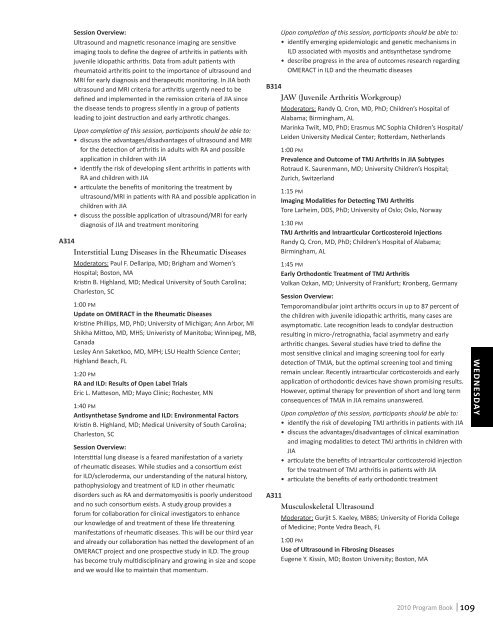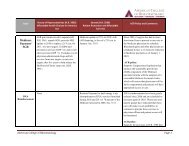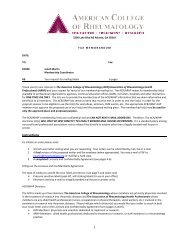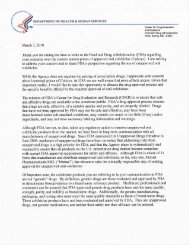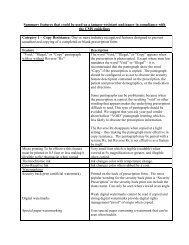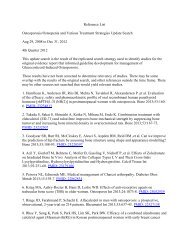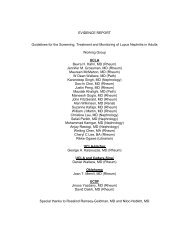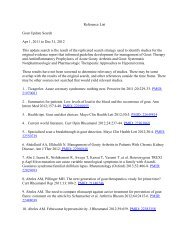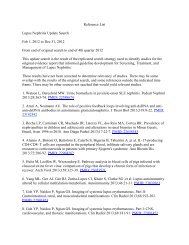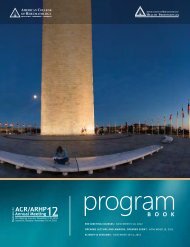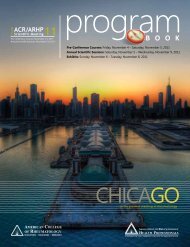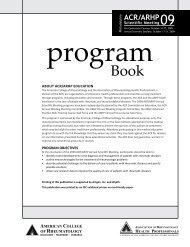B O O K - American College of Rheumatology
B O O K - American College of Rheumatology
B O O K - American College of Rheumatology
You also want an ePaper? Increase the reach of your titles
YUMPU automatically turns print PDFs into web optimized ePapers that Google loves.
Session Overview:<br />
Ultrasound and magnetic resonance imaging are sensitive<br />
imaging tools to define the degree <strong>of</strong> arthritis in patients with<br />
juvenile idiopathic arthritis. Data from adult patients with<br />
rheumatoid arthritis point to the importance <strong>of</strong> ultrasound and<br />
MRI for early diagnosis and therapeutic monitoring. In JIA both<br />
ultrasound and MRI criteria for arthritis urgently need to be<br />
defined and implemented in the remission criteria <strong>of</strong> JIA since<br />
the disease tends to progress silently in a group <strong>of</strong> patients<br />
leading to joint destruction and early arthrotic changes.<br />
Upon completion <strong>of</strong> this session, participants should be able to:<br />
• discuss the advantages/disadvantages <strong>of</strong> ultrasound and MRI<br />
for the detection <strong>of</strong> arthritis in adults with RA and possible<br />
application in children with JIA<br />
• identify the risk <strong>of</strong> developing silent arthritis in patients with<br />
RA and children with JIA<br />
• articulate the benefits <strong>of</strong> monitoring the treatment by<br />
ultrasound/MRI in patients with RA and possible application in<br />
children with JIA<br />
• discuss the possible application <strong>of</strong> ultrasound/MRI for early<br />
diagnosis <strong>of</strong> JIA and treatment monitoring<br />
A314<br />
Interstitial Lung Diseases in the Rheumatic Diseases<br />
Moderators: Paul F. Dellaripa, MD; Brigham and Women’s<br />
Hospital; Boston, MA<br />
Kristin B. Highland, MD; Medical University <strong>of</strong> South Carolina;<br />
Charleston, SC<br />
1:00 PM<br />
Update on OMERACT in the Rheumatic Diseases<br />
Kristine Phillips, MD, PhD; University <strong>of</strong> Michigan; Ann Arbor, MI<br />
Shikha Mittoo, MD, MHS; Univeristy <strong>of</strong> Manitoba; Winnipeg, MB,<br />
Canada<br />
Lesley Ann Saketkoo, MD, MPH; LSU Health Science Center;<br />
Highland Beach, FL<br />
1:20 PM<br />
RA and ILD: Results <strong>of</strong> Open Label Trials<br />
Eric L. Matteson, MD; Mayo Clinic; Rochester, MN<br />
1:40 PM<br />
Antisynthetase Syndrome and ILD: Environmental Factors<br />
Kristin B. Highland, MD; Medical University <strong>of</strong> South Carolina;<br />
Charleston, SC<br />
Session Overview:<br />
Interstitial lung disease is a feared manifestation <strong>of</strong> a variety<br />
<strong>of</strong> rheumatic diseases. While studies and a consortium exist<br />
for ILD/scleroderma, our understanding <strong>of</strong> the natural history,<br />
pathophysiology and treatment <strong>of</strong> ILD in other rheumatic<br />
disorders such as RA and dermatomyositis is poorly understood<br />
and no such consortium exists. A study group provides a<br />
forum for collaboration for clinical investigators to enhance<br />
our knowledge <strong>of</strong> and treatment <strong>of</strong> these life threatening<br />
manifestations <strong>of</strong> rheumatic diseases. This will be our third year<br />
and already our collaboration has netted the development <strong>of</strong> an<br />
OMERACT project and one prospective study in ILD. The group<br />
has become truly multidisciplinary and growing in size and scope<br />
and we would like to maintain that momentum.<br />
Upon completion <strong>of</strong> this session, participants should be able to:<br />
• identify emerging epidemiologic and genetic mechanisms in<br />
ILD associated with myositis and antisynthetase syndrome<br />
• describe progress in the area <strong>of</strong> outcomes research regarding<br />
OMERACT in ILD and the rheumatic diseases<br />
B314<br />
JAW (Juvenile Arthritis Workgroup)<br />
Moderators: Randy Q. Cron, MD, PhD; Children’s Hospital <strong>of</strong><br />
Alabama; Birmingham, AL<br />
Marinka Twilt, MD, PhD; Erasmus MC Sophia Children’s Hospital/<br />
Leiden University Medical Center; Rotterdam, Netherlands<br />
1:00 PM<br />
Prevalence and Outcome <strong>of</strong> TMJ Arthritis in JIA Subtypes<br />
Rotraud K. Saurenmann, MD; University Children’s Hospital;<br />
Zurich, Switzerland<br />
1:15 PM<br />
Imaging Modalities for Detecting TMJ Arthritis<br />
Tore Larheim, DDS, PhD; University <strong>of</strong> Oslo; Oslo, Norway<br />
1:30 PM<br />
TMJ Arthritis and Intraarticular Corticosteroid Injections<br />
Randy Q. Cron, MD, PhD; Children’s Hospital <strong>of</strong> Alabama;<br />
Birmingham, AL<br />
1:45 PM<br />
Early Orthodontic Treatment <strong>of</strong> TMJ Arthritis<br />
Volkan Ozkan, MD; University <strong>of</strong> Frankfurt; Kronberg, Germany<br />
Session Overview:<br />
Temporomandibular joint arthritis occurs in up to 87 percent <strong>of</strong><br />
the children with juvenile idiopathic arthritis, many cases are<br />
asymptomatic. Late recognition leads to condylar destruction<br />
resulting in micro-/retrognathia, facial asymmetry and early<br />
arthritic changes. Several studies have tried to define the<br />
most sensitive clinical and imaging screening tool for early<br />
detection <strong>of</strong> TMJA, but the optimal screening tool and timing<br />
remain unclear. Recently intraarticular corticosteroids and early<br />
application <strong>of</strong> orthodontic devices have shown promising results.<br />
However, optimal therapy for prevention <strong>of</strong> short and long term<br />
consequences <strong>of</strong> TMJA in JIA remains unanswered.<br />
Upon completion <strong>of</strong> this session, participants should be able to:<br />
• identify the risk <strong>of</strong> developing TMJ arthritis in patients with JIA<br />
• discuss the advantages/disadvantages <strong>of</strong> clinical examination<br />
and imaging modalities to detect TMJ arthritis in children with<br />
JIA<br />
• articulate the benefits <strong>of</strong> intraarticular corticosteroid injection<br />
for the treatment <strong>of</strong> TMJ arthritis in patients with JIA<br />
• articulate the benefits <strong>of</strong> early orthodontic treatment<br />
A311<br />
Musculoskeletal Ultrasound<br />
Moderator: Gurjit S. Kaeley, MBBS; University <strong>of</strong> Florida <strong>College</strong><br />
<strong>of</strong> Medicine; Ponte Vedra Beach, FL<br />
1:00 PM<br />
Use <strong>of</strong> Ultrasound in Fibrosing Diseases<br />
Eugene Y. Kissin, MD; Boston University; Boston, MA<br />
wednesday<br />
2010 Program Book 109


